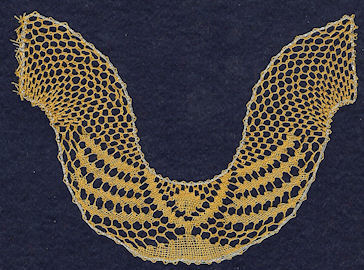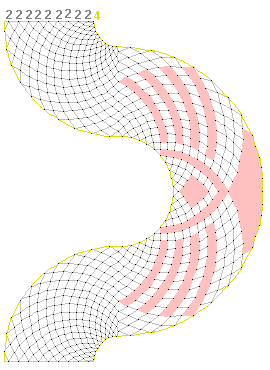

This could be used as a Christmas decoration. I don't think it would work as a tree decoration. Perhaps it could decorate a card. Click here for more Christmas decorations.

Pattern:

Bobbins: 22 pairs
Style: Torchon
Stitches:
cloth stitch
cloth stitch and twist
twist pair
Details:
cloth strip (red)
cloth triangle (red)
cloth diamond (red)
double Torchon ground (grey)
Winkie pin cloth footside (yellow)
circle shape
Description:
Follow the links above for explanation of how to work the different parts of the lace.
This is in the sequence of angel patterns, pattern 115, pattern 116 and pattern 117. The working is similar except it uses double Torchon ground (for strength). The edge is Winkie pin cloth footside with two passive pairs on each side. I used gold metallic thread for this, to frame the lace. Also as part of the frame, all four passive pairs start at the same place, and two of them work in cloth stitch across all other pairs at the start so they get to the other side of the lace. A similar thing happens at the end. At one point, the passives of the footside disappear into the solid cloth stitch of the triangle.
The pattern is described as 'Angel in a strange shape', and it is a very strange shape! The part that the angel is in is the bottom half of pattern 116, so the bottom half of a circle with a hole in the middle. The top half of the circle (without any angel) is cut in two, and the two quarter circles are fastened onto either side of the angel's half circle. The trickiest part is that in some places the pin holes are rather close together, and in others, they are spread further apart. The edges where the pin holes are far apart would benefit from the edge pair being twisted several times, to strengthen the edge. Where the pin holes are close together, you may need no more than the standard cloth stitch and twist of the footside, without any further twists at all. Apart from this, when working the lace, work from one edge, and find the necessary four pairs for each stitch, and you should find it possible to figure out what to do, even if the threads come from odd directions!
© Jo Edkins 2016 - return to lace index